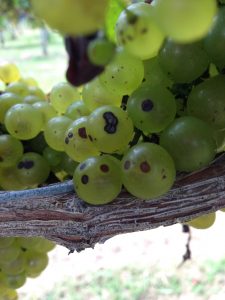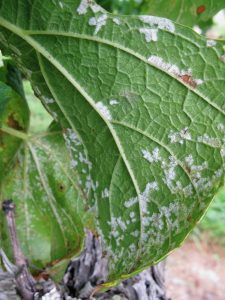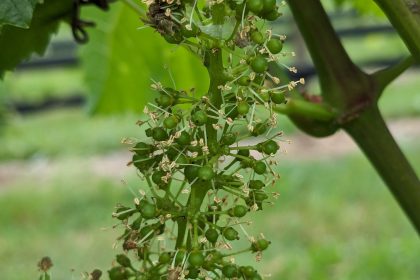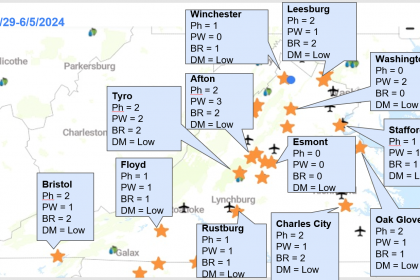Phomopsis cane and leaf spot
One of the diseases you need to consider soon after bud break is Phomopsis cane and leaf spot. It causes minor leaf spots, which are more evident to our eyes, but necrotic lesions cause more critical damage on shoots and rachis. It also causes berry rot; however, it is not common with wine grapes because of our spray programs.

The Phomopsis pathogen requires water for infection, and Phomopsis spores can germinate in a relatively cool environment (the upper 40s). This pathogen produces spores in spring from previously infected canes and cordons. Thus, springtime rain events are ideal for the development of Phomopsis. It is vital to protect young tissues from the older canes and trunks when they come out because we do not have any curative fungicides against Phomopsis. This disease typically takes a while to establish in the vineyard. It may take 4-5 years for Phomopsis to become noticeable after you start a new vineyard. However, getting rid of this disease is difficult once established in a vineyard. The fungus survives in canes and trunks that were infected in previous years, and it can cause damage to cordons and trunks. In other words, this disease can cause long-term damage to cordons and trunks. Some cultivars, such as Viognier, Cabernet Sauvignon, and Seyval Blanc, are more susceptible to Phomopsis than others.
If rain events are coming into the picture after bud break, mancozeb (FRAC = M3, Penncozeb, Dithane, Manzate, etc.), Ziram (FRAC = M3), and captan (FRAC = M4) are useful protective materials against Phomopsis. Since shoots will proliferate quickly, you may need to spray several times against Phomopsis, depending on how much rain we receive. One or two applications, starting from 1-2 inch shoot length and repeated seven to ten days apart, are sufficient in a typical year. After that period, your downy mildew or black rot applications, which happen in the late spring, will cover Phomopsis.
QoI (FRAC = 11), such as Abound and Pristine, and SDHI (FRAC = 7), such as Luna Experience, Miravis, and Aprovia, are also effective. However, you will probably need these materials for the latter part of the season to control other diseases (e.g., ripe rot and bitter rot).
Anthracnose
The other disease you may need to consider around this time of the year is anthracnose, which is more common with certain hybrid species. Typical symptoms are black necrotic lesions on leaves, shoots, and fruits, and often, the black lesion has an ash-colored center, as if you burnt the leaf or shoot tissue with a cigarette. The management strategies will be similar to that of Phomopsis, and in addition to the list above, Topsin-M (FRAC = 1) is also known to be effective.

Dormant application
A dormant application of lime sulfur (10% in our study, or 1% with Sulforix) is effective against both Phomopsis and anthracnose. With the corrosiveness of lime sulfur, it is hard to justify the money and time; thus, the low rate of Sulforix is appealing to me. There was a study done in Michigan where a mancozeb application was also successful; however, with the limit of the volume of mancozeb applications per year (~ 19.4 lb a.i. per year per acre, please check your label), you may wish to keep it to protect green tissues. We found a fixed copper to be ineffective. The dormant fungicide application can reduce Phomopsis to some extent; however, the application’s efficacy is not strong enough to allow you to skip any preventative fungicide applications to be sprayed soon after bud break. The dormant application knocks down spores produced on the infected canes, but it won’t protect new shoots. Therefore, you still need to protect your shoots when they emerge.
Although I see the benefit of the dormant application, it is another application you need to make. Also, it is more effective to spray mancozeb or captan soon after the bud break. Thus, I typically recommend a dormant application of lime sulfur only if you have a severe Phomopsis and/or anthracnose issue and need an extra kick to your regular preventative application after bud break.
The dormant application is less likely to be effective against downy or powdery because both are called polycyclic diseases with a rapid secondary cycle. Even if you can knock down the initial inoculum, they can rapidly produce the next round of spores, especially under favorable conditions. These pathogens’ winter survival structures are very tough, so I don’t think the dormant time fungicide application is the best approach. The dormant application of lime sulfur is used for ripe rot prevention in Japan. However, not much data confirms whether the efficacy is valid. If you are interested, please let me know so we can set up a trial.
Downy mildew
Downy mildew has become one of our most problematic diseases in the past several years. Especially if you had an outbreak in 2022, you might wish to tighten up your spray schedule to protect your vines better. Some people refer to the three-tens rule, 10 cm shoots, 10 mm rain, and 10 C in temperature (4 in, 0.4 in, and 50F) for the initial spray timing, meaning we need to spray soon after bud break. (This rule may make more sense in arid regions.) This will give us another reason to spray for Phomopsis so that the same spray covers for downy mildew.

Protective materials for downy mildew are Mancozeb (FRAC M3) [Gavel has mancozeb + zoxamid (FRAC 22)], Captan (FRAC M4), Fixed copper (FRAC M1), Revus or Forum (FRAC 40), or Zampro (FRAC 40 + 45), or Ranman (FRAC 21)). NOTE: there are increasing cases of Revus-resistant downy mildew isolates in VA. Plus, resistance to Ranman is known among downy mildew pathogens of other crops. Kickpack materials are phosphonate (Phostrol, Prophyt, etc. FRAC P07) and Ridomil products (FRAC 4).






This Post Has 2 Comments